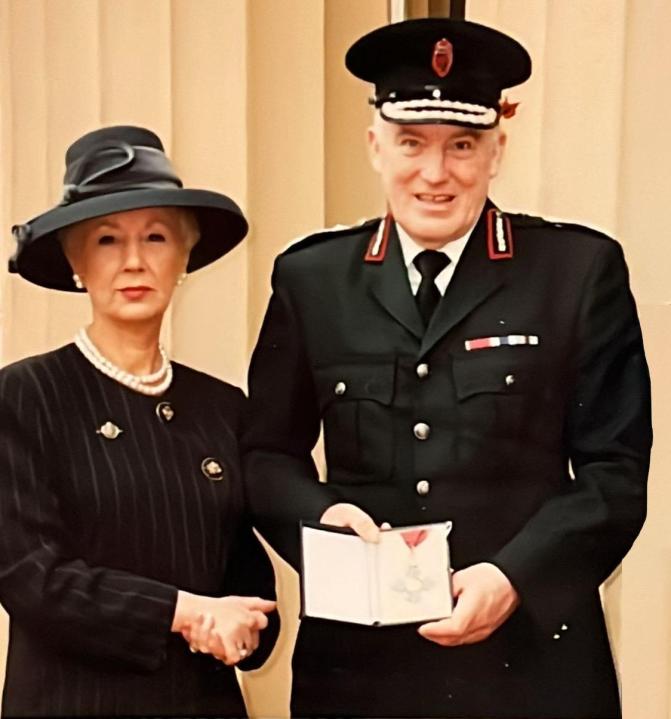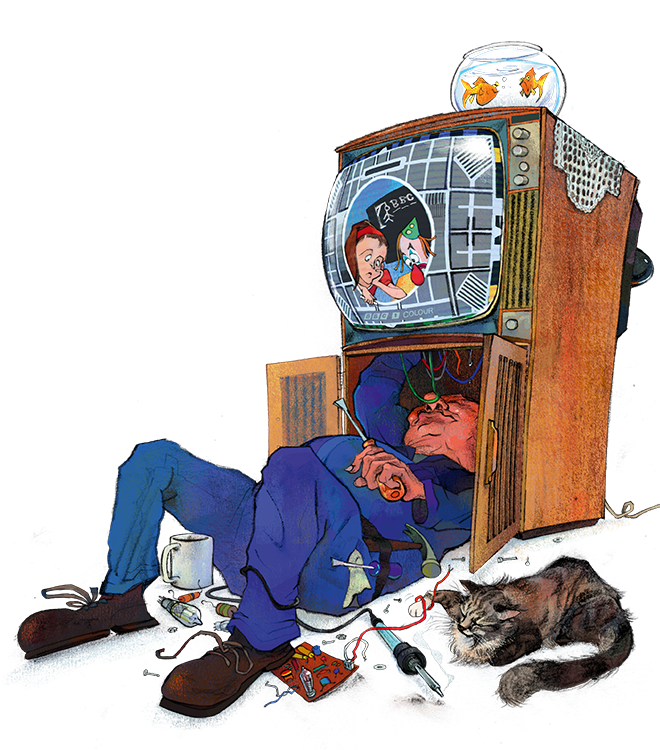The names of leading republicans like Gerry Adams, Martin McGuinness and Bobby Sands are well known, but how many in Great Britain can identify a Chief Constable of the Royal Ulster Constabulary – or, indeed, a single security force hero of the Troubles?
Blair Wallace, who has died aged 87 and will be buried tomorrow, was just such a hero. He was the last of the “big beasts” of the RUC Chief Officers from the height of the conflict, rising to the post of Deputy Chief Constable – until he lost out on the top job in 1996.
Wallace led from the front and was injured five times during the Troubles
He was a walking history book, serving 42 years, a stint unimaginable in any force nowadays. His career stretched from the abortive IRA Border Campaign of 1956-62, through to the aftermath of the Belfast Agreement of 1998.
Wallace was present when the first RUC officer murdered in the Troubles, Constable Victor Arbuckle, was slain by west Belfast loyalists in 1969; he carried the dying Gunner Robert Curtis to an ambulance, the first regular soldier to be killed by republicans, in 1971; and, by a miracle, was not on the Chinook helicopter which crashed at the Mull of Kintyre in 1994, wiping out the cream of RUC Special Branch and much of the rest of the senior intelligence community in the Province; he knew 25 out of the 29 fatalities on that flight.
He led from the front and was injured five times during the Troubles. When loyalists protested the renaming of Londonderry as Derry in 1984, a constable was pulled over the crush barrier by the crowd. Wallace, then an Assistant Chief Constable, did not hesitate to intervene in support of the officer, wielding his thirty inch blackthorn stick (the privilege of carrying those used to be accorded to senior officers from the days of the old Royal Irish Constabulary).
Wallace was then kicked on the ground by a dozen loyalists – until he was rescued by Detective Inspector Austen Wilson. Wilson was subsequently murdered by an IRA booby-trapped bomb at Magee College in Londonderry; Wilson’s colleague, Detective Sergeant John Bennison, was decapitated in the blast. Derryman Martin McGuinness watched it all from a discreet distance.
Rev Ian Paisley was often called “Big Man” by his admirers; but the term much more accurately applied to the modest, impeccably non-sectarian Wallace who never self-promoted. “Big” was literally true: like so many other Chief Officers of the RUC during the Troubles – Harry Baillie, Trevor Forbes, Sir Jack Hermon, and Michael McAtamney – Wallace stood at well over six foot tall.
It’s hard now to recreate the atmosphere of an era when senior officers were such powers in the land. But with Northern Ireland on the verge of full-scale civil war, they needed to be. The RUC, descended directly from the old pre-Partition Royal Irish Constabulary, was the UK’s only gendarmerie-style force. It imbued its recruits with a military ethos; the standards of spit and polish at the old RUC training depot at Enniskillen, Co Fermanagh, where Wallace started his career, were drilled into young men by ex-Irish Guardsmen in rifle-green uniforms, originally derived from the Rifle Brigade.
This austere military-style atmosphere imparted a certain sense of cohesion that later enabled the RUC to survive by the skin of its teeth during the early years of the Troubles.
Wallace seemed like out of central casting – and, at one level, that is just what he was. Born of Ulster-Scots Covenanting stock in Carrickfergus, Co Antrim, in 1937, his life was bounded by four Fs: family (married to Heather, his wife, for 61 years); faith (a member of Ballynure Presbyterian Church); farming (a keen amateur breeder of a herd of pedigree Limousin cattle); and the force (never a “police service”, though the spirit of service lay at the heart of his being).
Despite sometimes appearing to be a typical “truculent Ulsterman”, Wallace was, in fact, a consistent moderniser at the peak of the terrorist campaign. Or, as Clement Attlee once observed in another context, Wallace’s rare gift was to place “new wine into old bottles”.
When the Troubles broke out in 1969, the 3,000-strong RUC was unable to keep order on its own; it suffered the humiliation of the Army being sent in and often shunting it aside. “The old guard of the RUC leadership melted away like snow in a ditch,” recalled Wallace. Younger officers were often left to their own devices to begin the task of rebuilding.
Wallace had not started off in Special Branch, but from 1974 he became one of the key figures in the expansion and reorganisation of the RUC intelligence gathering system – the jewel in the crown of a new force that would eventually rise to a total of 13,000 and which was to be the spearhead of “Ulsterisation”. Police primacy was the watchword now.
But new responsibilities meant a new professionalism. The old pre-Troubles RUC believed it had little to learn from “outsiders”. Wallace knew otherwise: RUC research and analysis was poor and its agent handling and exploitation of intelligence were rudimentary. The IRA and loyalist campaigns that were bigger than anything the RUC had encountered before; critically, the RUC faced unprecedented levels of media scrutiny.
Wallace was the dynamo who routinely brought in outside expertise to the Province. He played a key part in sending far more officers for training at key centres such Bramshill and the FBI Academy.
In 1980, Wallace served as RUC liaison to the Walker report – perhaps the most significant of 17 (or, by some counts, 18) reports on the workings of Special Branch since the start of the Troubles. It was authored by Patrick Walker, who later became Director-General of the Security Service. It recommended centralisation of all intelligence gathering aspects of the different departments of the force – including CID, Firearms and related Forensics – under Special Branch.
There was a certain irony here: if anyone kept everything in his head, it was Wallace. He had an elephantine memory for everything and everyone in the Province: who was related to whom, in the security forces and terrorist organisations alike, and when and where they had served their time. He was also the pre-eminent exponent of the use of genealogy as a tool of understanding terrorist organisations; Wallace well understood that there were multi-generational families of informers inside the republican movement, too.
Will we be able to call upon men and women of the calibre of Wallace when the next round comes?
Wallace was the perfect foil for Walker. Both men were the antithesis of “nine to fivers” and Wallace would remove anyone who could not keep pace with the new regime he installed. Indeed, when Wallace lowered his glasses down his nose, that was a sure indication of coming trouble – a gesture which struck fear into generations of officers.
He knew that Branch work was not for everyone – and when he relieved someone of their duties, he did so gently. He did not want “sacked” officers to return into the wider RUC family alleging there was a “force within a force”. Wallace was prescient about this problem: such allegations subsequently formed part of the Patten Commission’s indictment of the RUC in 1999. This was followed by the transfer of the lead role in national security work in the Province to V Branch of MI5.
Wallace and Walker knew the law inside out (although in the counter-terrorism and national security space in this era, the law was then far more “minimalistic” than it has since become). The new guidelines for agent handling regularised recruitment of informers by the force as a whole, replacing individual officers doing “solo runs” with personalised recruitments – and were now centrally recorded.
The relationship with Walker reflected one of the unexpected themes of Wallace’s career – his diplomatic skills with senior “Brits”, including Army officers such as General Sir Michael Rose, then commander of 39 Infantry Brigade in Belfast. Wallace put many of his reforms into operational practice as head of Belfast Special Branch, where he played a key part in the first Tasking and Coordination Group (TCG). The security system that Wallace and others had designed and operated was so successful in penetrating the Provisionals that by the early 1990s, four out of five IRA attacks in the Province were being thwarted.
Thanks to the deep penetration of the Provisionals by the RUC and other agencies, “armed struggle” became subject to a law of diminishing returns; the security forces’ efforts thus played a key part in forcing the republican movement to go down the political route. The result was the first IRA ceasefire of 1994.
But the security forces and RUC Special Branch, in particular, subsequently received far too little credit for this achievement. The prospect of massive reform of the RUC became a key “stocking filler”, given by the Blair Government to Sinn Fein to keep them on a non-violent path in the face of challenges from Dissident Republicans.
Accordingly, under the Belfast Agreement, the Blair Government set up a Commission on policing chaired by former Hong Kong Governor Chris Patten – whose 175 recommendations stripped the force of its Royal title, the right to display pictures of the Sovereign under a new “clean walls” policy and much of its ethos – all in an attempt to gain consent for a new policing service in the new Northern Ireland from nationalists and republicans.
Wallace was due for retirement anyhow. But well before the Patten report was published, he discerned the direction of travel and recognised that he could not live with such sweeping changes.
General David Petraeus, the greatest practitioner of the counter-insurgency arts in this era, found much to learn from ex-RUC officers
Maurice Hayes, a prominent Catholic public servant who played a key role on the Patten Commission, wryly observed after the Belfast Agreement: “We didn’t empty the prisons of terrorists in order to fill them full of police officers and soldiers”.
It hasn’t literally turned out that way, but it’s close enough – as Wallace himself feared. The RUC may have prevailed on the streets, but assorted anti-State activists and Republicans are relitigating Troubles in courtrooms and in the halls of the academy.
Retired RUC officers, and particularly ex-Branchmen, are once again at the sharp end of a very different kind of spear: the running of undercover agents is a particular target of critics of the Troubles-era security forces, who allege that such activity constituted a form of “collusion” with loyalist and republican paramilitaries as part of a “dirty war”.
These aging officers are still being hauled before the Police Ombudsman of Northern Ireland and countless inquests. Wallace voluntarily appeared in 2012 before the de Silva inquiry into the murder by loyalists of the Republican solicitor Pat Finucane in 1989; but his peerless advice on the procedures and methodologies of the security system seems to have found little favour in the final report.
Ironically, just as the old RUC was being consigned to the often hostile history books at home, it was enjoying greater vogue than ever overseas: General David Petraeus, the greatest practitioner of the counter-insurgency arts in this era, found much to learn from ex-RUC officers who helped him in Iraq. All that was part of Wallace’s legacy.
It is a world turned upside down – the sorry tale of a State that will not adequately protect and honour its finest servants. But will we be able to call upon men and women of the calibre of Wallace when the next round comes?








Comments